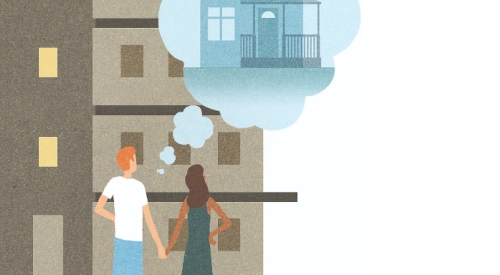|
 |
 |
| Hannah real estate developers' Adams Mill River House and Mill River House (above) luxury condominium complexes include a percentage of for-sale affordable units within an integrated housing model as part of an inclusionary housing ordinance in Stamford, Conn. |
Affordable housing is in crisis, and it looks like there's no end in sight. Even as sales have slowed and home prices have come down, home ownership is still out of reach for many. So-called workforce housing — for city workers and public servants such as police officers and teachers — is scarce in urban areas, forcing many to purchase homes in the suburbs and exurbs and face long commutes. And as the subprime lending crisis has shown, many folks were able to qualify for loans that will come back to bite them as their rates adjust upward and they can no longer afford their monthly mortgage payment.
Where does the home builder fit into this picture? What can and should home builders, who are facing their own crisis, do to help buyers afford their own home? A combination of creative business solutions in collusion with state, local and federal government incentives can make a difference and create a win/win/win situation for builders, potential home buyers and society at large. Though it sounds like an unlikely alliance, there are builders of affordable home projects that have done it and are willing to share their secrets of success.
Several factors contribute to the lack of affordable homes. During the housing boom, there was high demand for homes and lack of available land on which to build.
"We all remember Levittown [New York] after World War II," says Conrad Egan, president and CEO of the National Housing Conference, an affordable housing advocacy organization. "Mr. Leavitt went out to the potato fields of Long Island and built acre after acre of small but attractive homes. ... We don't have those kinds potatoes fields anymore."
The dearth of land has driven up home costs, and available land can be difficult to acquire through permitting processes that are often slow and complex — or land is zoned for commercial and industrial use or low densities that make it a poor candidate for building affordable homes.
While the cost of the average home has increased significantly over the last few years, incomes have not. Harvard University's Joint Center for Housing Studies' 2007 State of the Nation's Housing Report says five years of stagnating or declining incomes have added to housing affordability problems. In spite of meager gains in 2005, the median real income for all households fell 2.7 percent between 2000 and 2005.
Financial experts say expenses for housing should not exceed a third of income. But today many people spend 40 to 50 percent of their income on housing. According to "Housing for Working Families," a report published by The Center for Housing Policy, some five million working families spent half or more of their monthly incomes on the costs of owning or renting a home in 2003 — an increase of 60 percent since 1997.
So it's not just those on welfare, the underemployed and undereducated who are in need of affordable housing. Moderate income, college-educated professionals are feeling the pinch and often can't afford to live in the urban areas where they work.
The problem of affordable housing is understandable and unfortunate, but builders have businesses to run. Is it builders' responsibility to provide solutions to America's social ills?
Not necessarily, but in the long run it's in your best interest. There is a connection to the availability of affordable housing and the economic viability of the cities in which builders build.
Major employers don't want to relocate to and invest in communities where potential employees can't afford to live. These places won't be able to attract jobs, and fewer jobs mean fewer people who can spend money on goods and services and pay taxes —or buy homes.
"You have places like Phoenix that, at one time, was very attractive to employers, and it experienced a significant economic boom as a result," says Egan. "Now the people the city is trying to attract ... are beginning to have second thoughts. And those who relocated their companies or part of their operations there find that their employees are having a real hard time."
Government and the private sector share a vested interest in providing affordable housing in their communities. Ironically, their best bet at getting them built is in partnership with each other. The public sector needs the expertise of professional builders to produce quality homes. And as builders know, the public sector has a lot of say over what, where and when builders can build.
 |
The public sector has to make it worthwhile for builders. Without incentives, Mike Fink, president of Leewood Real Estate Group in New Jersey, says it's close to impossible for a market-rate builder to build and sell affordable homes.
"When we build a three-bedroom, two-bathroom town home in an inner city in New Jersey where the land is cheap, it's going to cost us probably about $235,000 to $250,000 per townhouse," Fink says. "We're going to sell that for about $140,000 or less in order to reach into this demographic. So you can see that unless there are some government incentives involved to close that capital gap of about $80,000 to $100,000 a unit, there's no possible way to do it."
There are almost as many grants, loans and programs to address the production of affordable homes as there are municipalities in which such homes can be built. There are mandated and voluntary inclusionary zoning ordinances. Some of these ordinances include density bonuses; if builders agree to set aside a specific amount of units in a project for affordable buyers, they are allowed to build more units on the land. There are financial incentives, housing funds and subsidies, Low Income Housing Tax Credits (geared toward rental units) and the like.
Many local and state governments will specify what buyers qualify for discounted housing. To qualify for workforce housing in New Jersey, Fink says your income must be between 35 and 120 percent of median income for the area.
"It ranges from about $45,000 a year up to about $80,000 a year," says Fink. "It depends upon the year, too. It can go as high as $95,000 a year. That's the median. For low income, it would be up to 50 percent of that. And for moderate income it's up to 80 percent of that."
The more builders know about what programs are available locally — and the pros and cons of each - the better position they are in to combine them to come up with a development deal that makes local government get on board.
And you'll need to win over communities with folks who may agree in principle that it's a good thing - just not in their backyard. Builders should be prepared to make the case to these groups about the mix of people in need of affordable housing: working families, elderly couples on fixed incomes, singles beginning their careers - even children or parents of people currently living in a community may need affordable housing so that they can continue to live there.
Developments with a mix of market-rate and discounted units are often better-received by communities and municipalities than projects that propose all affordable homes.
"We as developers have been separating people by income since World War II," says Cito Beguiristain, vice president of Auburn Development Group. "In order to create sustainable communities - sustainable socially, historically, culturally, and socially - a mixed-income approach is the proper approach. When you isolate people by income, especially in the lower ranges, kids grow up without financial role models — the business owner, the young lawyer. At the lower income ranges they don't even have the school teacher or police officer living next to them."
|


















